The age of Light Personal Aircraft is not far off in the future but is that where “fast-glass” LSA are headed?
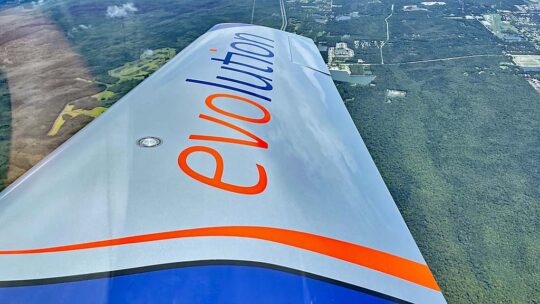 Certainly, some LSA producers have ambitions for four seat cruisers or tougher bush aircraft or larger load-carrying aircraft to satisfy pilots that want more capability from their aircraft.
Certainly, some LSA producers have ambitions for four seat cruisers or tougher bush aircraft or larger load-carrying aircraft to satisfy pilots that want more capability from their aircraft.
Those goals are fine, of course, but they are not what stimulates leaders and engineers at JMB Aircraft, a restless bunch that loves flying their screaming machine as fast as they can.
How fast is it? I went aloft with dealer Kyle Schluter to find out.
I also learned about the fuller product line and what Sport Pilot certificate holders can do to own and fly one of these impressive aircraft. (Article updated 7/17/21)
Orange Lightning in the Sky
Maybe it doesn’t look familiar but VL3 has already been seen by Yankee pilots under the brand name Gobosh and with the model designation 800XP. Gobosh emerged in the early days of LSA. Today you know this aircraft as VL3 and it doesn’t seem the same.
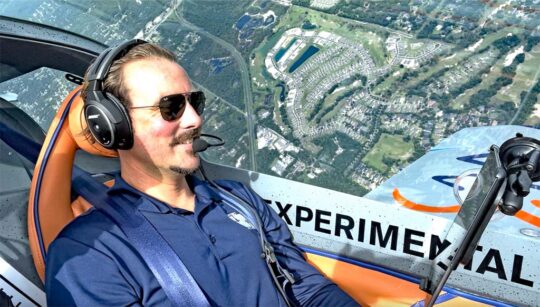
Irony: The older model is essentially the LSA version that JMB plans for the U.S. market. So, yep, while the model in this report is the speediest version, a simpler — and LSA compatible today, even before the 2023 regulations — model is already waiting for American pilots that many need or prefer an LSA.
No question though… what gets most pilot hearts beating harder is the speed VL3 has been able to achieve with a Rotax engine.
VL3 was already known as a very fast flyer …and then Rotax introduced their 141-horsepower 915iS. Engineers at JMB eagerly accepted the challenge of adding the potent new powerplant to their sleek airframe and the results are strong.
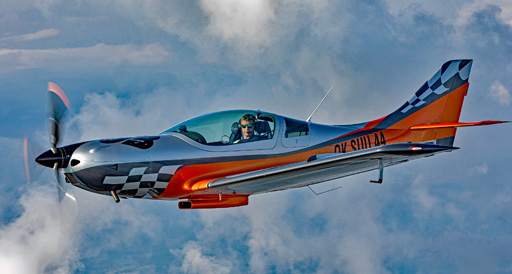
When American builders go the Czech and work on building their kit to qualify, as presently needed, as an Experimental Amateur Built aircraft, they can take full advantage of the speed potential of this airplane. Of course, that procedure may change after 2023 when LSA are allowed to fly faster or when VL3 can become a Light Personal Aircraft with even more capability.
You should note that JMB, along with most Euro designers, likes to quote max speeds in not only true airspeed but in kilometers per hour. I don’t blame them. It makes the number higher and if you don’t think this has any meaning then you probably don’t understand a product priced at $29.95, either. People are affected by a number and 370 kilometers per hour certainly does sound fast.
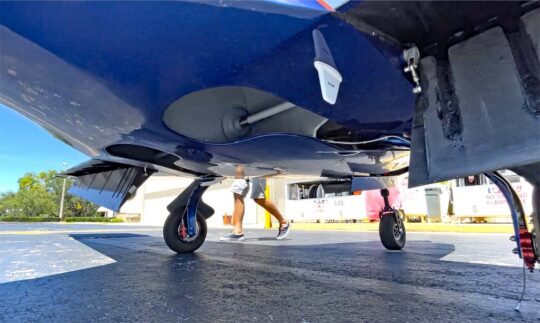
VL3 has retractable gear with full gear door covers.
VL3 is able to achieve these speeds thanks to a very clean all-carbon-fiber airframe. The model also has a relatively short span (under 28 feet).
The company lists climb rate at 2,000 feet per minute, a 2,000-kilometer (1,250 statute mile) range and a fairly modest 600-foot takeoff roll. Those are certainly very strong bragging rights, and on my recent flight, I found these numbers believable.
Safety Figures High, Too
Safety is important to JMB engineers as well. I flew in a VL3 with an airframe ballistic parachute. That’s one feature but hardly all. In fact, it’s for last-resort use.
JMB reports that VL3’s airframe has been subjected to a rather amazing +15 Gs of positive load and –8 Gs of negative load. That occurred in a test to failure; normal operational limits are +5 –2.5 Gs. VL3 is not intended for aerobatics but can stand up to the rigor of higher speed flight.
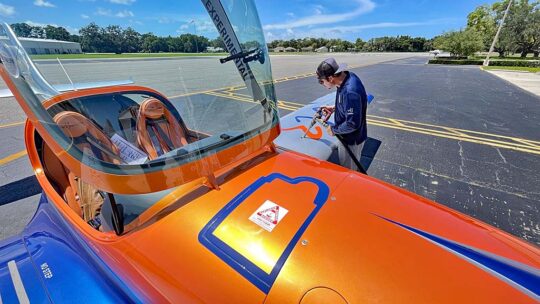
Kyle Schluter fills VL3’s left tank (32 gallons can be carried). In the foreground you see the parachute mount location with the breakaway edges.
Pilots have tested VL3 up to 248 knots indicated airspeed (459 kph or 285 mph) to determine if flutter appears. It did not.
An Angle of Attack (AoA) indicator appeared on the Garmin G3X to help the pilot stay within safe speeds. As do many LSA producers, JMB includes an ELT, promotes on-screen traffic advisories, plus stall strips have been fitted near the wing/fuselage junction to improve controllability at slower speeds.
Given JMB salesman talk about speed all the time, you may start to wonder as I did. OK, fine, it blazes, I thought, but what are its slow speed characteristics? Some previous fast-glass designs have so focused on speed that a short off-field landing could be threatening because landing speeds remain high. Not on VL3.
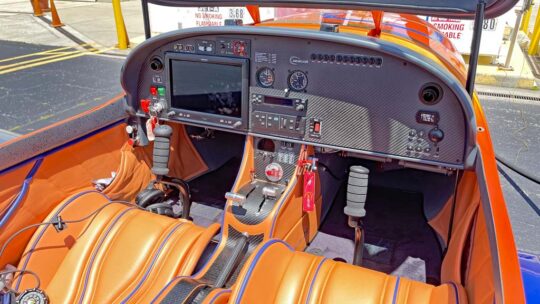
VL3 has a well-refined automotive-like interior finish.
As Kyle approached to land, he lowered flaps to 15 degrees; this setting is used for takeoff as well. Using 33 degrees substantially steepened approach and the full-down 55 degrees of split flaps are needed only for the shortest field.
As he lowered flaps and worked to slow down this race horse, I was pleased to see how well behaved VL3 remained.
I had a clue because we did a series of stalls and VL3 had already shown great slow speed stability and control but also remarkably slow speeds. Stall happens modestly in the low 40 knot range. From 42 knots or so stall to 165 indicated top cruise, we see the 4:1 slow-to-max ratio that is the holy grail of airplane design.
Now in the US of A
With import operations based on the West Coast, Alion Aviation engaged dealers in the Midwest and the east to help promote and service the aircraft.
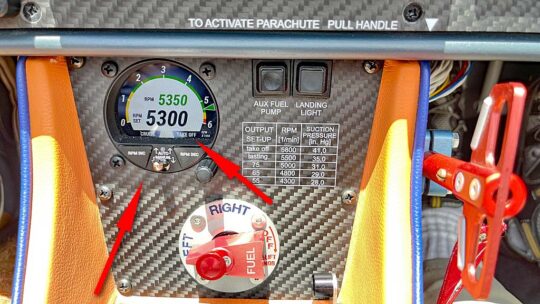
Left arrow identifies the prop control on VL3. The right arrow shows presets you can make, in this case, takeoff setting. Note parachute handle at right.
One of these is a father and son team, Dirk and Kyle Schluter, located in Ohio. They will provide sales and service to many eastern states from Maine to Florida. Another dealer group, David Pauly and Aaron Young, is based in Wichita, Kansas serving the central states while Alion Aviation importer and company CEO Adam Coubal is based in California and serves the West Coast.
More to Come… On the flight I took with Kyle, we shot video for a Video Pilot Report to follow in which you will learn more about speeds, power settings, engine temperatures, flight controls, stall characteristics, slow flight, maneuvering, takeoff and landing and more. Watch for that video after AirVenture 2021.
No question about it — VL3 is one of those aircraft that will catch your attention.
Good luck catching one in the sky.
TECHNICAL SPECIFICATIONS
configured to ASTM 600-kilogram parameters or to U.S. EAB
per factory published information
specifications were enhanced on the factory’s advice (* 7/17/21)
- Wing Span — 27.7 feet (8,44 m)
- Wing Area — 105 square feet (9,77 sq m)
- Length — 20.5 feet (6,24 m)
- Height — 8.2 feet (2,05 m)
- Cabin Width — 45 inches (115 cm)
- Fuel Capacity — 31.7 gallons (120 l)
- Gross Weight (ASTM version) — 1,320 pounds (600 kg)
- Gross Weight (EAB version) — 1,500 pounds (680 kg) *
- Empty Weight (ASTM version) depending on optional equipment — 750 pounds (340 kg)
- Empty Weight (EAB version) before options — 798 pounds (362 kg) *
- Useful Load (ASTM version) — 573 pounds (260 kg)
- Payload with full fuel (ASTM version) — 383 pounds (174 kg)
- Useful Load (EAB version) — 702 pounds (318 kg) *
- Payload with full fuel (EAB version) — 512 pounds (232 kg) *
PERFORMANCE
with Rotax 914 or 915iS (912 also available)
- Takeoff & Landing either model — 757 feet (175 m)
- Best Rate of Climb with 914 — 1,560 feet per minute *
- Best rate of climb with 915iS — 2,280 feet per minute *
- Max Cruise Speed with 914 in true airspeed — 190 miles per hour or 165 knots (306 kph)
- Max Cruise Speed with 915iS in true airspeed — 230 miles per hour or 200 knots (370 kph)
- Stall Speed either model in indicated airspeed — 48 miles per hour or 42 knots (78 kph)
- Never-Exceed Speed (914) in indicated airspeed — 190 miles per hour or 165 knots (306 kph) * **
- Never-Exceed Speed (915iS) in indicated airspeed — 253 miles per hour or 220 knots (407 kph) *
** Vne limited by maximum parachute deployment speed
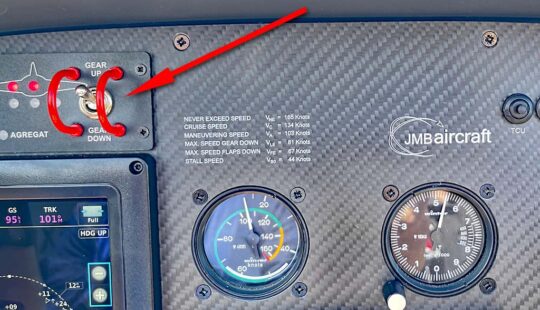
VL3’s gear switch has guards against inadvertent movement. Lights to the left of the switch plus an audio alarm warn the pilot about the gear when the flaps are lowered.


Who is the UK Dealer for the VL3 915is aeroplane?
I urge you to make your request directly of JMB who I’m sure can advise you of that answer.
What is the basic price of one of these planes?
I am certain the U.S. distributor, Alion Aviation, would be pleased to quote a price to you.
Hi John
What kind of legs can you fly with full fuel in 915 version?
Thanks,
Rafal
“Irony: The older model is essentially the LSA version that JMB plans for the U.S. market. So, yep, while the model in this report is the speediest version, a simpler — and LSA compatible today, even before the 2023 regulations — model is already waiting for American pilots that many need or prefer an LSA.”
Is this true? I read their brochure and talked with a rep and they said that the LSA version is almost identical to the other version except a few inches longer wing, fixed gear, and ground-adjustable prop but that the 915iS version can still get more than 150KTAS even the LSA version (only 120KCAS at sea level due to statement limiting RPM).
I’m sure the Gobosh 800XP is NOT the same as the VL3-C (the LSA model) even if they have the same parent.
I did not mean to imply the older Gobosh 800XP was identical to the fixed gear JMB of today but it has obvious similarities. Thanks for your more recent info. All interested parties should contact supplier Alion Aircraft for the best information.
Puh, Ihave tried it. It is tiny and you cannot get any luggage with you. I’m not a big guy but I could not fit inside comfortably.
I also saw that they only put on 5 gallons of fuel (he told that the factory say they should never use more for demos) so it was as light as possible to brag about the speed. So I asked them to fill it up like we normaly do. And then with full open trottle we could not get more than 130 knots. I asked him to give me 75% power and we did not Get more than 120 knots, and the plane felt sluggish.
But If you’re smaller than average and with less than half tanks, yes, then it is speedy.
So for AirVenture, ask to see how much fuel they use on demos and ask them to fill it up (they will refuse because then it is a totaly different plane).
John
Your experience does not match mine, John. You did not mention altitudes.
Hi John:
When and where did you get the demo? You must have been sitting in another airplane. VL3 has one of the roomiest interior in its class. Even a 6.5-foot guy like me fits inside. And the speeds you are mentioning are completely missleading and false — 130 knots would correspond with 912UL engine, which has less than 100 horsepower, no turbo, and no injection. That’s the bottom of VL3 powerplants options. You should try 914 Turbo or 915iS. Cheers!
I recently flew in one. I could not fit inside comfortably either but I was also flying in a plane that was designed specifically for shorter people. The factory has an XL version and they can customize it for larger people (limited only by raw cabin dimensions).
When I flew in a demo plane we got easily 180 KTAS (915 engine) with nearly full fuel and I am a big guy.
Does it look like the VL3 will be allowed through MOSAIC assuming a power index of 1.2? If retractable gears aren’t allowed even via endorsement for the new LSAs, how fast would this thing go?
Based on the latest from AirVenture 2021, it appears Power Index is going away. I think VL3 will be allowed as an LSA under some definition, but going further at this time is premature. We already know how fast this airplane flies with fixed gear and a fixed prop because we’ve seen it before under the brand name Gobosh; enter that into our search bar and see what you find.
What about included and/or optional avionics.
What is the price?
Is there one in the US available for demo?
For these answers and more information, contact Alion Aviation.
Hello,
I am very impressed and interested in an EAB Version.
I need the VL3 for rough surface landing, means torf or dirt.
Do I better use a fixed gear ?
Speed is not the most important for me.
More carry weight and land everywhere. But with max power on engine.
Please contact me via email.
What are the costs of such an VL3?
What you would recommand for my needs?
How to build, or let build?
I am ready to buy and build the VL3 in Florida in my hangar.
Please use the following link to contact Alion Aviation and ask your question directly.
How does the Swiss Excellence Risen EAB from Alberto Porto from sea-avio compare? Which one is more fuel efficent? How do numbers and flight stability compare at sea-level with Rotax 914is and 915is? Any differences in Auto Pilot capability. Autoland features possible? Any caracteristics to point out pro and cons for this comparison? Is it possible to fly IFR in IMC?
Please contact the companies involved to inquire further. Without the chance to compare both airplanes in identical conditions, it is impossible to accurately answer some of your questions.
Hi:
Connect with us here or directly through our website.
Thank you very much.
It would be nice to have some one contact the customers that are interested.
I’ve been on many sites with return [no] emails; just automated response emails.
The phone is not working at all.
Can you offer any help???
Controller.com has been down for couple days now.
Email me and contact info for this plane been looking for a month already.
To be sure you are contacting the right source, here is Alion’s contact info.
Wait, max cruise is _faster_ than VNE?
Sorry for the typographical error. It now matches.